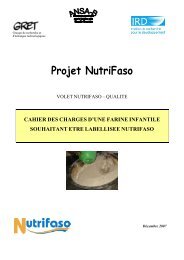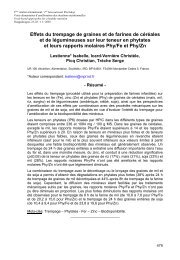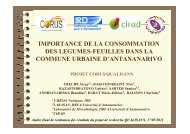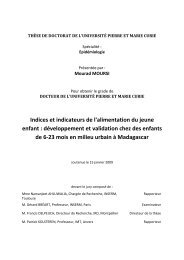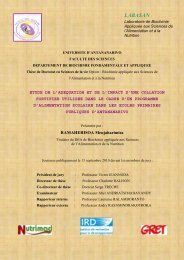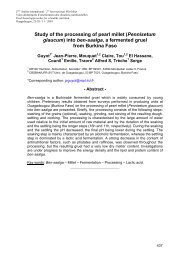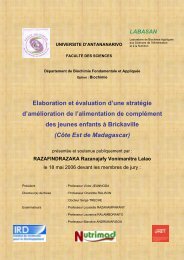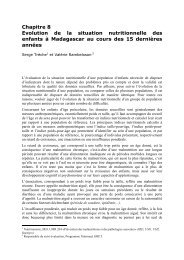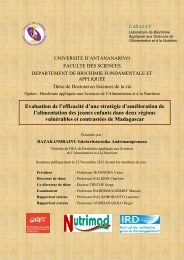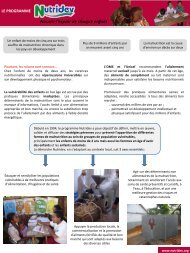THESE UNIQUE El Hassane Kéhien-Piho TOU - Nutridev
THESE UNIQUE El Hassane Kéhien-Piho TOU - Nutridev
THESE UNIQUE El Hassane Kéhien-Piho TOU - Nutridev
Create successful ePaper yourself
Turn your PDF publications into a flip-book with our unique Google optimized e-Paper software.
58<br />
E.H. Tou et al. / International Journal of Food Microbiology 106 (2006) 52–60<br />
mmol/l<br />
12<br />
10<br />
8<br />
6<br />
4<br />
2<br />
0<br />
0 2 4 6 8 10 12 14 16 18 20 22 24<br />
Settling time (h)<br />
glucose fructose maltose<br />
sucrose raffinose melibiose<br />
stachyose<br />
Fig. 6. Kinetics of sugar consumption in supernatant during settling in pilot<br />
scale experiments. Bars indicate standard deviation.<br />
the ANF responsible for digestive disorders, their degradation<br />
was also investigated to establish if they are eliminated<br />
naturally during processing.<br />
In contrast to phytates, the raffinose content in the grains<br />
decreased mainly during the soaking step probably due to the<br />
combined effect of diffusion and a-galactosidase activities.<br />
However, even if ANF content does naturally decrease during<br />
processing, ben-saalga, like many other traditional complementary<br />
foods (Lorri and Svanberg, 1993, 1994; Trèche and<br />
Mbome, 1999), is a diluted gruel that does not have the<br />
necessary energy and nutrient density to fulfill the nutritional<br />
requirements of infants and young children. To obtain a local<br />
gruel with the required nutritional characteristics (Trèche,<br />
1999; Lutter and Dewey, 2003; WHO, 1998), some modifications<br />
of the traditional process will be necessary, taking into<br />
account the skill of producers and thus relying on more detailed<br />
knowledge of processing conditions. Notwithstanding, apart<br />
from the nutritional aspects, more immediate benefits for the<br />
Lactic acid and ethanol (mmol/l)<br />
70<br />
60<br />
50<br />
40<br />
30<br />
20<br />
10<br />
0<br />
Unfermented wet flour<br />
Fermented paste<br />
Lac TPU Lac PSE Eth TPU Eth PSE<br />
Fig. 7. Comparison of the changes in lactic acid (Lac) and ethanol (Eth)<br />
concentrations in supernatant during settling between five traditional production<br />
units (TPU) and pilot scale experiments (PSE). Bars are for standard<br />
deviation.<br />
Table 4<br />
Counts of the aerobic mesophilic bacteria, lactic acid bacteria and yeasts in the<br />
unfermented wet flour and fermented paste in 12 TPUs<br />
Unfermented wet flour<br />
(log CFU/mlTS.D.)<br />
Fermented paste<br />
(log CFU/mlTS.D.)<br />
Aerobic mesophilic counts 6.5T0.4 7.1T0.4<br />
Lactic acid bacteria (LAB) 6.2T0.9 7.0T1.1<br />
Amylolytic acid bacteria (ALAB) 5.1T0.5<br />
6.1T0.4<br />
Yeasts 6.1T0.4 5.5T0.7<br />
Ratio LAB/yeast 1.01 40.02<br />
Ratio ALAB/LAB 0.10 0.12<br />
LAB: lactic acid bacteria; ALAB: amylolytic lactic acid bacteria; S.D.: standard<br />
deviation.<br />
sanitary quality of the gruels resulting from the traditional<br />
processing of pearl millet would be expected. The combination<br />
of a decrease in pH to values lower than 4.0 during the settling<br />
step, together with the simultaneous production of antimicrobial<br />
compounds by LAB (lactic acid and possibly bacteriocins)<br />
and a temperature near to boiling point during the final cooking<br />
phase would limit contamination by food-borne pathogens<br />
(Kingamkono et al., 1994; Lei and Jakobsen, 2004; Nout et al.,<br />
1989; Nout and Motarjemi, 1997).<br />
In spite of many studies describing the traditional processing<br />
of cereals by lactic acid fermentation, detailed information<br />
on fermentation kinetics is scant. In this study, particular<br />
attention was paid to providing an accurate description of the<br />
fermentation process combining observations made directly in<br />
several TPUs and at the pilot scale. Ben-saalga processing<br />
clearly includes two stages of fermentation, first alcoholic<br />
fermentation during soaking and then lactic acid fermentation<br />
during settling. The fact that lactic acid concentration is higher<br />
than ethanol during the first 8 h of settling indicates the<br />
metabolic heterogeneity of the LAB population, in which<br />
homofermentative and heterofermentative pathways are simultaneously<br />
active. Furthermore, it appears that from 8 to 24 h of<br />
fermentation, only the homofermentative or facultative heterofermentative<br />
LAB are active, suggesting a temporal variation in<br />
the microflora.<br />
High variability in the concentration of final products, such<br />
as ethanol and lactic acid during soaking and settling,<br />
respectively, was observed in the TPUs, and illustrates the<br />
need to find a suitable strategy to better control processing<br />
conditions. This is not only necessary to improve the<br />
nutritional characteristics of the gruel but also to obtain a<br />
foodstuff with constant food composition. This high variability<br />
might be due to variations observed in the duration of the<br />
different unit operations as shown in Fig. 1.<br />
Whereas lactic acid fermentation is a classical phenomenon<br />
during the settling step of cereal flours in many traditional<br />
forms of processing, this is the first time that the soaking step<br />
has been described in such detail and also associated with<br />
alcoholic fermentation. This is consistent with the fact that<br />
soaking the grains in water does not provide conditions<br />
favorable for the growth of lactic acid bacteria which have<br />
fastidious nutrient requirements, giving a competitive advantage<br />
to microorganisms with less stringent nutritional requirements<br />
such as some yeasts. In contrast, during settling nutrients<br />
such as proteins and vitamins from pearl millet could be made



